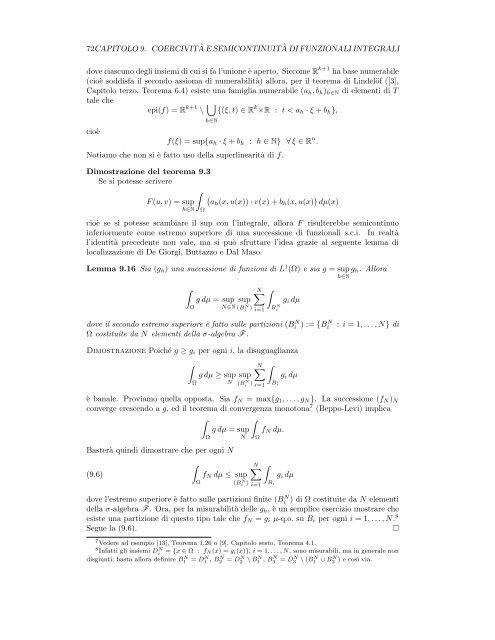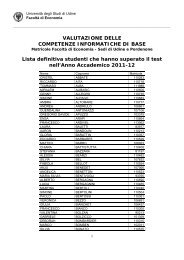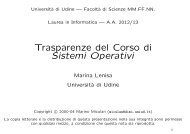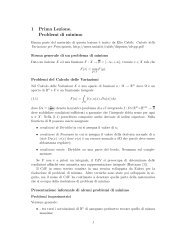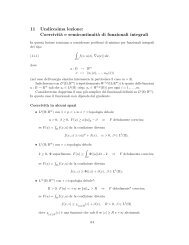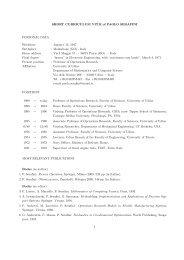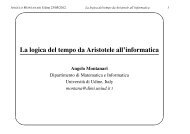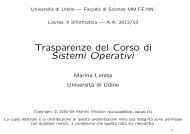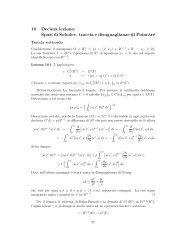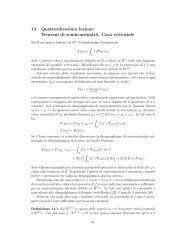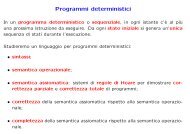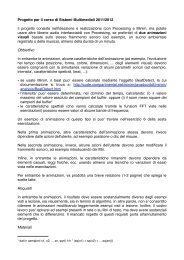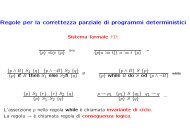Capitolo 9 - Dipartimento di Matematica e Informatica
Capitolo 9 - Dipartimento di Matematica e Informatica
Capitolo 9 - Dipartimento di Matematica e Informatica
You also want an ePaper? Increase the reach of your titles
YUMPU automatically turns print PDFs into web optimized ePapers that Google loves.
72CAPITOLO 9. COERCIVITÀ E SEMICONTINUITÀ DI FUNZIONALI INTEGRALI<br />
dove ciascuno degli insiemi <strong>di</strong> cui si fa l’unione è aperto. Siccome R k+1 ha base numerabile<br />
(cioè sod<strong>di</strong>sfa il secondo assioma <strong>di</strong> numerabilità) allora, per il teorema <strong>di</strong> Lindelöf ([3],<br />
<strong>Capitolo</strong> terzo, Teorema 6.4) esiste una famiglia numerabile (ah, bh)h∈N <strong>di</strong> elementi <strong>di</strong> T<br />
tale che<br />
epi(f) = R k+1 \ <br />
{(ξ, t) ∈ R k ×R : t < ah · ξ + bh},<br />
cioè<br />
h∈N<br />
f(ξ) = sup{ah · ξ + bh : h ∈ N} ∀ ξ ∈ R n .<br />
Notiamo che non si è fatto uso della superlinearità <strong>di</strong> f.<br />
Dimostrazione del teorema 9.3<br />
Se si potesse scrivere<br />
<br />
<br />
F (u, v) = sup ah(x, u(x)) · v(x) + bh(x, u(x)<br />
h∈N<br />
dµ(x)<br />
Ω<br />
cioè se si potesse scambiare il sup con l’integrale, allora F risulterebbe semicontinuo<br />
inferiormente come estremo superiore <strong>di</strong> una successione <strong>di</strong> funzionali s.c.i. In realtà<br />
l’identità precedente non vale, ma si può sfruttare l’idea grazie al seguente lemma <strong>di</strong><br />
localizzazione <strong>di</strong> De Giorgi, Buttazzo e Dal Maso.<br />
Lemma 9.16 Sia (gh) una successione <strong>di</strong> funzioni <strong>di</strong> L1 (Ω) e sia g = sup gh. Allora<br />
h∈N<br />
<br />
Ω<br />
g dµ = sup<br />
sup<br />
N<br />
<br />
N∈N (BN i ) i=1<br />
B N i<br />
gi dµ<br />
dove il secondo estremo superiore è fatto sulle partizioni (B N i ) := {BN i : i = 1, . . . , N} <strong>di</strong><br />
Ω costituite da N elementi della σ-algebra F .<br />
Dimostrazione Poiché g ≥ gi per ogni i, la <strong>di</strong>suguaglianza<br />
<br />
Ω<br />
g dµ ≥ sup<br />
N<br />
Ω<br />
sup<br />
N<br />
<br />
(BN i ) i=1<br />
Bi<br />
gi dµ<br />
è banale. Proviamo quella opposta. Sia fN = max{g1, . . . , gN }. La successione (fN )N<br />
converge crescendo a g, ed il teorema <strong>di</strong> convergenza monotona7 (Beppo-Levi) implica<br />
<br />
<br />
g dµ = sup<br />
N<br />
Basterà quin<strong>di</strong> <strong>di</strong>mostrare che per ogni N<br />
(9.6)<br />
<br />
fN dµ ≤ sup<br />
Ω<br />
(BN i ) i=1<br />
fN dµ.<br />
Ω<br />
N<br />
<br />
Bi<br />
gi dµ<br />
dove l’estremo superiore è fatto sulle partizioni finite (BN i ) <strong>di</strong> Ω costituite da N elementi<br />
della σ-algebra F . Ora, per la misurabilità delle gh, è un semplice esercizio mostrare che<br />
esiste una partizione <strong>di</strong> questo tipo tale che fN = gi µ-q.o. su Bi per ogni i = 1, . . . , N. 8<br />
Segue la (9.6). <br />
7Vedere ad esempio [13], Teorema 1.26 o [9], <strong>Capitolo</strong> sesto, Teorema 4.1.<br />
8Infatti gli insiemi DN i = {x ∈ Ω : fN (x) = gi(x)}, i = 1, . . . , N, sono misurabili, ma in generale non<br />
<strong>di</strong>sgiunti; basta allora definire BN 1 = DN 1 , BN 2 = DN 2 \ BN 1 , BN 3 = DN 3 \ (BN 1 ∪ BN 2 ) e così via.


